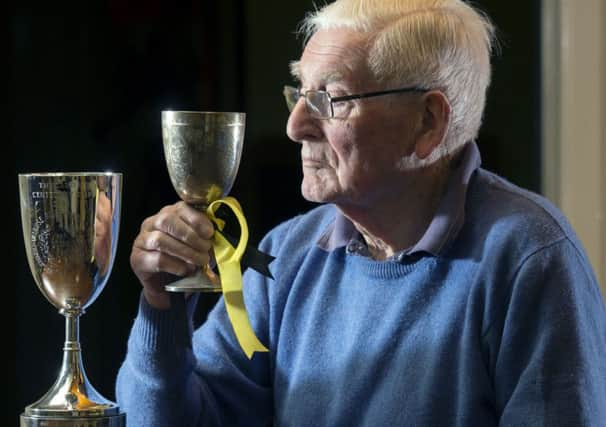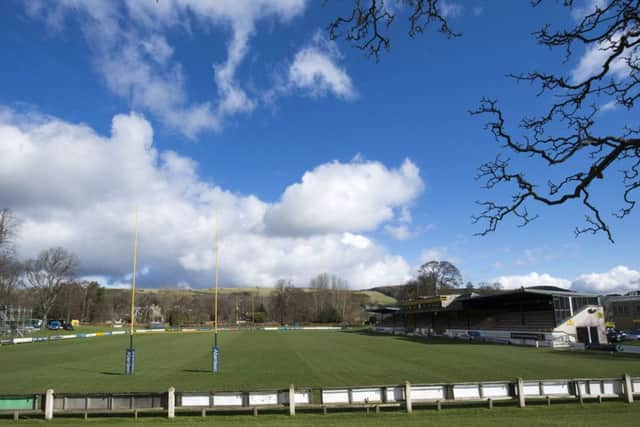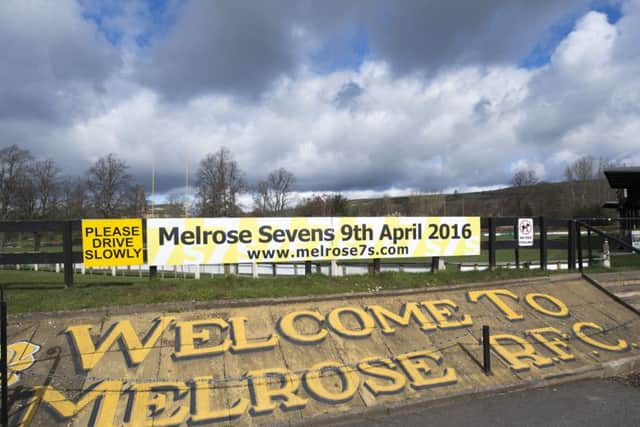Insight: How rugby sevens turns Melrose into the '˜Wild West'


With days to go before it hosts the world’s most famous rugby sevens tournament, the Melrose ground – known as the Greenyards – resounds to the clanking of metal. A row of horses standing along a ridge on the Eildon Hills lean forward for a better view as men in hard hats piece together the temporary stands. Their hi-vis jackets seem to have been chosen for the occasion, the luminous yellow a perfect match for the daffodils and the club’s colours, inspired by the town’s symbol, a yellow rose. So strongly does yellow feature in Melrose – from the signage above the clubhouse to the icing on its eponymous tarts – that if you weren’t in the heart of the No-voting Borders, you’d think you had stumbled into an SNP convention.
On Saturday, the town will be transformed – as it has been every April for the last 133 years – from an oversized retirement home to the centre of the rugby universe; its population will swell from 2,000 to up to 14,000 as visiting teams and spectators descend for the tournament. There will be sporting prowess, but there will also be spectacle: pipe bands, fancy dress costumes and children on the hunt for autographs. If the weather gods have smiled, the setting sun will cast a pale glow as the Ladies Cup is presented to the winning team. And when it ends, so many people will have over-imbibed that the sign reading “Pass Out” will seem less of an explanation of how to exit than a licence to collapse in a drunken heap.
Advertisement
Hide AdAdvertisement
Hide Ad“You’ve seen Melrose: it’s like the town in the film Hot Fuzz – very middle-class and sensible,” says Michael Crawford, who owns a building firm in the town. “Well that’s what it’s like for 364 days a year, but on the 365th it turns into the Wild West. The average age drops from 90 down to about 25 and it becomes full of life. It casts off its dowdiness and explodes into colour. It’s a really nice experience.”


Melrose has several claims to fame: it is the oldest continuous settlement in Scotland, its ruined abbey is the repository for the embalmed heart of Robert the Bruce and Walter Scott’s home Abbotsford sits nearby on a bank of the Tweed. But it is also the place where rugby sevens, a shorter, arguably more exciting, version of rugby union, was created way back in 1883 when the club was short of money. In the year that rugby sevens becomes an Olympic sport – it will make its debut in Rio in July – that’s no mean boast, even if the reputation of its “inventor”, butcher Ned Haig, is tainted by rumours he stole much of the credit from his boss David Sanderson. Whoever was responsible, the first event was a success and the sport took off. Rugby sevens is now played across the world and the annual Melrose tournament – sponsored by Aberdeen Asset Management – brings £2 million to the local economy. In the past, teams from the world’s top rugby nations have taken part (and have often found themselves out-classed by their Borders counterparts) and big names such as David Campese have generated great excitement. But Melrose Sevens has also been used to foster the sport in countries with little tradition of rugby, such as India and Singapore. The contribution made by Haig (or Sanderson) to the sport was recognised in 2008 when the Melrose Sevens was inducted into the IRB Hall of Fame.
That rugby sevens should have been invented in the Borders is unsurprising; rugby flows like blood through the arteries of the region. “It’s a second religion,” says Crawford. “In fact, it’s probably our first religion.” This being so, the Melrose Sevens is its most holy festival. When Crawford’s children were young, they preferred it to Christmas. Having grown up and migrated south, they return every April to stand in a part of the ground their father calls “idiots’ corner,” dressed in whatever wacky costumes their WhatsApp group has decided on.
Crawford’s own relationship with the Melrose Sevens began at the age of 18 months; left with his granny, he made a beeline for an open door and tottered after the crowds. He was taken to the police station. “I think my parents picked me up straight away, although they might have waited until the Sunday,” he says.
Advertisement
Hide AdAdvertisement
Hide AdAfter the tournament, his parents would always hold a house party; as the evening wore on, the players, turfed out of bars, would pitch up and stay until 5am. It was a tradition passed on to Crawford and his wife Debi. One year, the huge Irish Number 8 Neil Francis was standing with his back to their drinks cabinet necking a bottle of Bailey’s Original Irish Cream. “Debi asked me to take it off him, but I took one look at him and said: ‘No, he can drink as much Irish Cream as he likes’.” Another year, a stream of players arrived carrying bouquets of daffodils for Debi who was four months pregnant. “We thought: ‘How sweet’, but the following day we noticed they had been pulled out of every garden from Quarrydene to the Greenyards.”


The most fulfilling aspect of the Sevens for the Crawford family has been the friendships that have been formed through hosting members of visiting teams. Over the years, they have taken in players from Singapore, India, the US, South Africa and New Zealand. In 2004, when their youngest son Douglas was eight, they hosted Stanley Afeaki from Tonga; when the pair bumped into each other again last year, the two- foot gap in their respective heights had narrowed. Khosaan Jacobsz who visited from South Africa in 2010 became an adopted member of the family; he used their home as a base while he spent two years travelling.
Families have not been asked to host this year because the furthest any team is travelling from is Belgium. Organisers say they opted for a European theme because it was topical, but the move has fed into a fear that the Melrose Sevens is changing, and not necessarily for the better. Some say the event has become more formal, more tightly-policed and more corporate. Nowadays, the ground is fenced off to control movement and no alcohol is allowed into the ground. An on-site bar and eating concessions combined with traffic restrictions mean fewer people drift from the club to the town, though plenty of people without tickets still spend the day in bars, drinking and watching the event on TV screens. “It’s not what it used to be,” one shopkeeper says. “It’s all money, money, money.” On the plus side, the reopening of the Borders railway last year has revived one tradition, with large groups expected to make the trip to Tweedbank, then on to Melrose by shuttle bus.
Perhaps there’s always been an ambivalence towards the Sevens and the mayhem it brings within the wider community. “Ask bar-owners what they think of the event in October and they’ll say: ‘It’s great’,” says Crawford. “Ask them the day before and they’ll say: ‘hmmm’.”Ask them the day after and they’ll be too exhausted to answer.
Advertisement
Hide AdAdvertisement
Hide AdCrawford doesn’t miss when he compares Melrose to Sandford, the fictional town in Hot Fuzz, although with its chintzy tea shops and stone cottages overburdened with bas-reliefs cherubs and dancing frogs, it would sit just as easily in a David Lynch film; the kind where a veneer of respectability masks a seething undercurrent of depravity. Depravity is too strong a word to describe the antics on Melrose Sevens nights, but, if you imagine its botox-perfect streets littered with crumpled cans and their comatose consumers, you can see why residents might feel conflicted.


Nicholas Henderson, owner of Burt’s Hotel, which has been in his family for 50 years, loves the business the Melrose Sevens brings. All 20 rooms of his hotel were rebooked the day after last year’s event. He loves the event itself, but he knows the flowers in his window boxes aren’t long for this world.
In 2000 – when Burt’s Hotel had been refurbished – Henderson decided to change the way in which it operated on Melrose Sevens days. Where previously he had run an open house, with customers drinking from 11am to 11pm, he decided to restrict business to corporate lunches, suppers and dinners. Now no-one gets through the door unless they have pre-booked and have a voucher to prove it.
On Saturday, Henderson’s faux wood panelling wallpaper will be protected from collateral damage and his stag cushions will remain puke-free, but, as he talks, you can’t help but feel he has a hankering for the bad old days. “We used to take the furniture out of the bar,” he says. “All the pictures would come down and the curtains and the pelmets, and at 7am someone would arrive and start nailing hessian to the carpets.
Advertisement
Hide AdAdvertisement
Hide Ad“On the day, it would be so full it would reach saturation point. There would be people standing half way up the stairs; no-one would be able to get to the bar. It was just nuts.” Henderson recalls the piano being opened up and everyone singing; customers climbing in and out the window and girls who would buy four cokes and then take them into the toilets where they’d whip out a bottle of Smirnoff from their handbags. “It was good, but basically you were sucked in and you had to ride along the top of the wave until 11pm when the bar closed. Then it was “phew” and out with the yard brush to sweep up.”


Baker Craig Murray also profits from the Melrose Sevens. His shop Alex Dalgetty & Sons has taken lots of pre-orders – mostly rolls for barbecues and Melrose tarts which were invented by his father in a fit of comestible oneupmanship to rival the Selkirk Bannock and Hawick Balls. Murray is making 2,000 pies, a large proportion of which will be served at the ground, but many other shops will shut.
For two men whose lives have revolved around rugby, however, there is no flipside. At 90, Jack Dun is looking forward to his 76th Melrose Sevens with the same degree of excitement he mustered for the other 75. Sitting in the Ned Haig bar surrounded by rugby paraphernalia, he has three-quarters of a century worth of almanacs in his head; although, like many old men, the longer ago the event, the more clearly he recalls it. “In 1932, it rained and rained and rained,” he says (he must have been six at the time). He was eight the first year he attended. “Melrose beat Jed-Forest in the first tie and Royal High beat Kelso in the final.” Dun was club president for the centenary in 1983 and still has a role in organising the referees. Asked for a Melrose Sevens highlight, he picks 1937 when Gala had endured a bad 15-a-side season and met London Scottish in the final. “The late Tommy Carruthers dribbled from one end of the field to the other and scored between the posts and Jock Dun, a distant relation of mine, kicked the goal and Gala won,” he says.
Also in the Ned Haig bar is Jim Lauder – better known as Jim the Jannie – a volunteer who has spent most of his retirement working at the club. As property convenor, Lauder has to ensure the ground is ready for Saturday. A former Gala Star player and referee, he brings out a checklist and runs through his responsibilities. “I have to get the turnstile sorted, the goalposts, emergency cover, heating and boiler, electricians, drainage and the PA system. There’s the alarms and fire extinguishers, surface drainage and roof gutters, the water supply, skips, equipment and the executive cleaners.” There have been a few hitches. A leaking shower has caused wood to rot. “That’s got to be fixed before the Sevens,” he says. And two thermostats have gone on the boiler. “There’s always a last-minute crisis.”
Advertisement
Hide AdAdvertisement
Hide AdThough it’s hard to compete with Dun and Lauder for passion, few people in the town are immune to Melrose Sevens fever. They are proud of its roots, its prestige and its dramatic setting.
Away from the ground, a team of pensioners – also in hi-vis jackets with Melrose in Bloom emblazoned on the back – are litter-picking in a patch of woodland. They go out in groups to ensure no stray sweet packet or unwatered plant pot will scupper their chance of bringing home another trophy. For them the Sevens means disruption. They are braced for butt ends in the begonias and French letters in the French marigolds. Later in the month, they will organise the town’s annual spring clean, sending a task force of 250 volunteers to make sure every square inch is pristine. But they too recognise the value of the event. “We’re the top tourist town in the Borders,” says Val Miller. “The Melrose Sevens puts us on the map.”